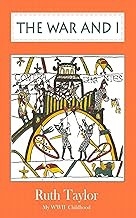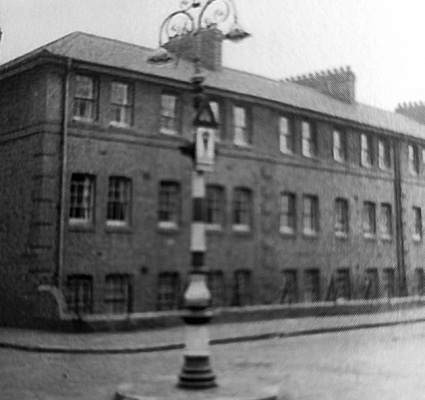The War And I: My WWII Childhood
THE WAR AND I: My WWII Childhood
By Ruth Taylor
Reviewed by Wendy Blumfield
Readers of ESRA Magazine will be familiar with the name of Ruth Taylor from her article about Isaac (Jack) London, her late father who managed the Victoria Boys Club in the East End of London.
Her memoir about her childhood in wartime London was originally written for her family and friends, to make sure that the stories of war in London and evacuation to live with strangers would not be forgotten. However, as a professional artist and qualified English teacher, she realised that these stories were part of the social history of that time and she widened her targeted market, producing a beautiful illustrated volume available to the general public.
Born in 1932, the youngest of six children, Ruth describes the cramped conditions in the Council flat in Clark Street where at least they had an indoor flush toilet, a luxury in working-class dwellings. While her mother cared for the home and children, her father worked in a tailoring factory.
Their family life pre-war was typical of the Jewish community in the East End. Outside the home, the children mixed with those of Irish descent and other immigrants. These stories of multi-ethnic family life describe a warm and secure environment in spite of poverty and disease, contrasting so much with the devastation of the war to come.
Knowing that bombing was inevitable, shelters were prepared and sandbags stacked in front of homes. Blackout rules were strictly observed and the streets were dark and inhospitable. When the bombing started, warning sirens gave residents little time to get to a shelter. Most air raids happened at night, bringing people out of their beds. Many families who had their own shelters settled in them for the entire night in order not to have to disturb sleeping children repeatedly. The bombing intensified until the Blitz, continual nights of destruction and death. Those who did not have their own shelters headed for the Underground stations with their bedding and supplies for the children.
Men who were too old for recruitment served as Civil Defence wardens and fire-fighters, so many mothers were left alone to cope with the fear and protection of their families.
Equally traumatic for Ruth were several periods of evacuation and separation from her family. Even before war was declared, the evacuation process was established and at the age of 7, Ruth was one of the children at Aldgate Station with a name label, a gas mask and food for the journey to an unknown destination. Life was very different from anything she had known. The family who took her in were kind but she grieved for her family and wept much of the time. In time she made friends and enjoyed the countryside, but her parents' occasional visits were disastrous. On one occasion her mother found her infested with head lice, another time Ruth could not let her mother go and was hysterical until her adopted uncle sent her out to buy fish and chips for their supper.
With the Phoney War and no bombing many families brought their children home, but at the age of nine, after a period back home, she was once again sent to strangers. This time she was the only evacuee and she felt quite isolated until she started school with a teacher who inspired her love of learning and literature.
Although Ruth had stayed in London during the Blitz, her parents were determined to find a safe refuge for her again and this time she was sent to Wiltshire, the furthest she had ever gone. The advantage was that part of the evacuated Jewish Latimer and Godolphin School was in the village. The headmaster and his wife regularly invited children to celebrate Shabbat and festivals. It was at this billet that Ruth was truly loved and cherished by the family and she maintained contact for many years.
On returning to London Ruth prepared for her grammar school entrance exams, then taken at the age of 11. She passed and was excited to get her new school uniform. Her father proudly made her blazer which she promptly lost. In spite of continued wartime, she enjoyed this new phase of her education and loved learning the sciences and arts. Ruth's mother was a music teacher and encouraged her to play.
As the "buzz bombs" worsened, nobody felt safe. It was already 1944, a long and exhausting war. The Germans had a new weapon. These were pilotless planes that droned over the cities. When the drone stopped, the engine stalled and the bomb dropped with no warning. The Habonim organization were caring for Jewish children in Devon. Most of the children were refugees from Europe and the home was run as a commune. This awakened Ruth's vision of Zionism and her father was not too pleased when she announced her plans to go to Palestine in the future.
Ruth describes the celebrations on 8 May, 1945, VE Day. Thousands of Londoners streamed up the Mall to Buckingham Palace where the Royal Family appeared on the balcony. This was followed by a huge street party in their neighbourhood. Readers feel with the writer the sense of relief and return to an almost normal life.
However the aftermath of the war brought horrendous stories of the Holocaust and of persecution and atrocities throughout Europe. At home, grieving families were mourning the losses both of loved ones serving in the Armed Forces and those who died in the bombing. Food rationing continued another 9 years.
Ruth has made aliyah twice with numerous travels and adventures in between. In 1963 she moved to Israel with her first husband and she completed a B.A and M.A. at Haifa University, also working as a teacher of English as a Foreign Language. Having graduated from the St. Martin's School of Art in London, she is a gifted artist and set up a ceramic tile business. Following her divorce in the early 1980's she returned to England, remarried and was also reunited with her own siblings and extended family. In 2013 she returned to Israel and is now settled in Haifa. Ruth has three sons and a daughter.
"The War and I: My WWII Childhood" by Ruth Taylor.
Available from Amazon and from the author, e-mail:This email address is being protected from spambots. You need JavaScript enabled to view it.










Comments